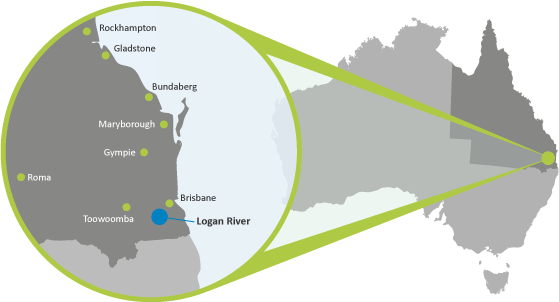Past review
The Logan River water supply scheme is located in the Logan River Basin.
The scheme was established following construction of Maroon Dam in 1974.
Since then, new water storages have been developed, namely:
- Cedar Grove Weir
- Bromelton Weir
- South Maclean Weir
- Bromelton Off-Stream Storage
- Wyaralong Dam.
The Logan River water supply scheme has 136 irrigation customers whose major uses of irrigation water include fodder crops, grain and horticulture.

The QCA has released its final recommended prices for the Logan River scheme for 2013-17. The Minister accepted the QCA’s recommendations.
Logan River water charges
| 2013-14 | 2014-15 | 2015-16 | 2016-17 | |
|---|---|---|---|---|
| Fixed ($/ML WAE) | 23.11 | 25.74 | 28.48 | 29.28 |
| Variable ($/ML Use) | 9.98 | 10.23 | 10.49 | 10.75 |
In the Logan River water supply scheme, cost-reflective volumetric charges are lower when compared to 2012-13.
To maintain revenues, the balance not recouped by volumetric charges is recovered by fixed charges which are higher than current levels.
As current revenues are below cost-reflective revenues, the QCA recommends price paths where fixed charges increase annually by $2 per ML (plus inflation) until cost-reflective levels are reached.
Volumetric charges are increased at inflation over the balance of the regulatory period.
This Seqwater water scheme review forms part of the review that the QCA undertook in 2012-13 for the Queensland Government: the Seqwater Irrigation Price Review 2013–17.
You can read more about the pricing review on our project home page. You can also view the submissions for the water schemes that we received, the consultants’ reports and issues arising from face-to-face consultation with stakeholders.
We recommended a new irrigation price path, to apply from July 2013 to June 2017 – with prices moving in a direction that better reflect costs.
- Key to the findings were the recovery of Seqwater’s costs and the smoothing of future price increases.
- All Seqwater schemes will now have two-part tariffs consisting of a fixed (Part A) price per megalitre (ML) of nominal water allocation and a usage (Part B) price per ML of water use.
- For the majority of schemes, our recommended prices result in increases to fixed prices and reductions in usage prices.